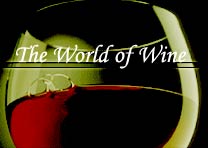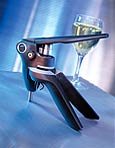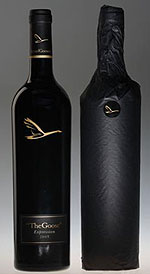 Fine Wines by The Goose
Fine Wines by The Goose

 Great news for The Goose!
Great news for The Goose!
We are delighted to announce that we just have been awarded a Silver Medal each for both Goose Wines.
This follows the first Bronze Medal which we received by Decanter last year for The Expression Cabernet Sauvignon / Shiraz 2005.
This year we got a Silver Medal each by The Decanter World Wine Award 2009 for The Expression Cabernet Sauvignon / Shiraz 2007 and The Goose Sauvignon Blanc 2008.
Congratulations to Alwyn Liebenberg and his Team!
News: Sauvignon Blanc 2008 Vintage ahs just arrived!
Stock for sale available - just give us a call 01344 627 411
Retief "The Goose" Goosen
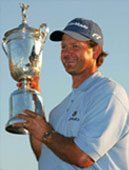 |
| Retief Goosen |
Retief Goosen was born in Polokwane, formerly known as Pietersburg, South Africa. He turned professional in 1990, following a win in the South African Amateur Championship of the same year. His main achievements since have been two U.S. Open wins in 2001 & 2004 and heading the European Tour Order of Merit in 2001 and 2002 respectively.
Since 1995, Goosen has been one of the most consistent players in the world. He has won internationally every year since 1995 and also won a PGA Tour event every year from 2001 to 2005. In addition to his numerous achievements, he had enjoyed for a long period of time a position in the top 5 of the Official World Golf Rankings, and in 2006 reached a career-best third place. Since July 9, 2007 he is ranked 11th in the world but obsevers suggest it may be linked to his change of swing and the enlistment of a coach.
Goosen is known for his extremely calm demeanor, a trait that has earned him the nickname "The Iceman" on the PGA circuit. He is also affectionally referred to as "The Goose". He further enhanced his reputation as a steely competitor at the 2004 U.S. Open, where he mastered Shinnecock Hills’ extremely fast and arguably unfair greens, draining clutch putt after clutch putt.
Retief Goosen is married and has a son and a daughter. He either resides in Ascot in Berkshire England, Orlando, Florida USA or in Polokwane, South Africa.
See Golfing events for this year in the Events Calendar.
Our Vision
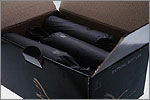 It is not only said of wine, but proven over centuries, that it is indeed “the vineyard that makes the wine”. If Schoonberg were to be the home of world class Cabernet Sauvignon, Shiraz and Sauvignon Blanc then it would be fundamentally up to the soil and climate to ensure that the grapes deliver their optimal blueprint in terms of excellence in flavour.
It is not only said of wine, but proven over centuries, that it is indeed “the vineyard that makes the wine”. If Schoonberg were to be the home of world class Cabernet Sauvignon, Shiraz and Sauvignon Blanc then it would be fundamentally up to the soil and climate to ensure that the grapes deliver their optimal blueprint in terms of excellence in flavour.
By 1999 were planted 6 hectares of Cabernet Sauvignon followed by 6 hectares of Shiraz in 2000. Following the success of the first two cultivars planted, the year 2002 saw an additional 6 hectares added to the expanding vineyard. This planting was the popular Sauvignon Blanc and it wasthe first phase long-term vision for Schoonberg.
After the onset of 2004 the winery was on more than one occasion amply rewarded for the faith and judgment of the soil and climate of the Langkloof valley. For proof, several coveted awards had been bestowed, the grapes and the wines were subsequently mastered.
It was eventually through the teaming up of a diverse and talented group of men that this vision and brand excellence would be fulfilled. One was with Dr. Werner Roux, a medical doctor turned businessman and the other with professional South African golfer Retief Goosen.
Five years after joining the family business in 1995, Werner also completed his M.B.A. in Strategic Marketing at the University of Hull (U.K.). Over and above the business talent he brings to The Goose Wines, he remains actively involved in numerous Roux-family business interests ranging from sugar to real estate and property development.
To compliment the talented team, a better ambassador for their Langkloof vineyard than Retief Goosen is unlikely. For many more reasons than golfing alone, Retief has a particular passion for the Garden Route and so much else that makes sense about this unique region. That a world-class wine should be part of it stands for good reason.
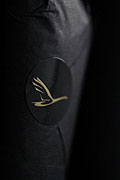 In short, The GooseWines aim to become a leading international brand. Not for volume or quantity in bottles produced but for QUALITY, UNIQUENESS, and wines renowned for their superb COMPLEXITY and ELEGANCE
In short, The GooseWines aim to become a leading international brand. Not for volume or quantity in bottles produced but for QUALITY, UNIQUENESS, and wines renowned for their superb COMPLEXITY and ELEGANCE
A gift straight from the Indian Ocean…
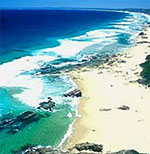 Schoonberg was one of several family farms scattered throughout the Klein Karoo. Nestled in the picturesque Langkloof valley near Uniondale the sprawling 460 hectares of family land spread out and up against a north-facing slope of the Outeniqua Mountains. Again the winemakers were drawn to the magnificent peak of Duiwelskop, a familiar landmark that rises above the fertile soil like an untiring sentinel. Draping the mountain peak was a tablecloth-like cloud. The winemakers knew that the white shroud they were looking at was the effect of evaporation from the surface of the warm Indian Ocean hardly 15 kilometres away, as the crow might fly.
Schoonberg was one of several family farms scattered throughout the Klein Karoo. Nestled in the picturesque Langkloof valley near Uniondale the sprawling 460 hectares of family land spread out and up against a north-facing slope of the Outeniqua Mountains. Again the winemakers were drawn to the magnificent peak of Duiwelskop, a familiar landmark that rises above the fertile soil like an untiring sentinel. Draping the mountain peak was a tablecloth-like cloud. The winemakers knew that the white shroud they were looking at was the effect of evaporation from the surface of the warm Indian Ocean hardly 15 kilometres away, as the crow might fly.
For inhabitants of the valley this phenomenon is a common sight during the "dog days of summer". The water vapour is carried up into the atmosphere by convection currents and then, finding just the right conditions for condensation at the approximate altitude of Duiwelskop peak, cloud formation suddenly appears, seemingly out of thin air.
On the inland side of the mountain a dry and thirsty Karoo air sucks up the welcome moisture as it enters the valley rim. The cloud now takes on the appearance of a phantom waterfall as cool moist air spills into the valley below. Where the gift from the ocean comes into contact with the parched Karoo air, the illusion of liquid water vanishes as if by an act of magic. Minutes later the fields in the valley below are awash with cool, moist and life-sustaining air.
Already familiar with the soil and all else that would make the perfect vineyard at Schoonberg, the winemakers knew that the ocean-cooled air that sustains this beautiful valley would become one of the key elements in accomplishing their goals and dreams for the vineyards that would soon grace the majestic slopes of Schoonberg.
The Area - The Story - To Summarise
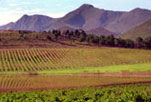 The Area: The Upper Langkloof Valley in the southern Cape of South Africa has been known for it’s wild and untamed nature. In the 19th Century this Valley was visited by game hunters from the coastal towns during the winter months to stock up with fresh game meat and hides. The skins were salted and the meat cured in barrels and carted with ox-wagons over the dangerous Outeniqua mountains to the settlements on the coast. In the 1840`s Farmers settled in this fertile Valley to farm cattle, sheep and grain pastures. Later the area was found suitable for apple and apricot farming and soon many Farmers started exporting these fruits to Europe. The famous Appletiser brand had a strong contract with many Farmers for their apples to produce apple juice. The upper Langkloof (long valley) runs east/west to the north of the Outeniqua mountains, only 15 km from the Indian Ocean coastline. situated 2500 ft above sea level. The Valley is known for a dry and cold climate. The annual average rainfall is about 250mm to 300mm. Strong and cool summer winds rush in on shore off the coast every day, and rise over the 5000 ft mountain range cooling even more. These winds bring in cold and moist air which cools down the Valley during summer to temperatures of 20 to 23 degrees, while the nearby Karoo bakes away at 40 degrees in summer. Extreme Terroir and an exciting region, motivated me to install a weather station and research the area for the possible planting of vineyards in 1993. Soil samples and profile holes were sunk to determine the soil types and structures, to accurately determine the proper vine selection of cultivar for planting.
The Area: The Upper Langkloof Valley in the southern Cape of South Africa has been known for it’s wild and untamed nature. In the 19th Century this Valley was visited by game hunters from the coastal towns during the winter months to stock up with fresh game meat and hides. The skins were salted and the meat cured in barrels and carted with ox-wagons over the dangerous Outeniqua mountains to the settlements on the coast. In the 1840`s Farmers settled in this fertile Valley to farm cattle, sheep and grain pastures. Later the area was found suitable for apple and apricot farming and soon many Farmers started exporting these fruits to Europe. The famous Appletiser brand had a strong contract with many Farmers for their apples to produce apple juice. The upper Langkloof (long valley) runs east/west to the north of the Outeniqua mountains, only 15 km from the Indian Ocean coastline. situated 2500 ft above sea level. The Valley is known for a dry and cold climate. The annual average rainfall is about 250mm to 300mm. Strong and cool summer winds rush in on shore off the coast every day, and rise over the 5000 ft mountain range cooling even more. These winds bring in cold and moist air which cools down the Valley during summer to temperatures of 20 to 23 degrees, while the nearby Karoo bakes away at 40 degrees in summer. Extreme Terroir and an exciting region, motivated me to install a weather station and research the area for the possible planting of vineyards in 1993. Soil samples and profile holes were sunk to determine the soil types and structures, to accurately determine the proper vine selection of cultivar for planting.
It was found that the Valley has an annual temperature of only 17 degrees Celsius (very cool for S.A!) The soils are from Table Mountain sandstone and shale combination. Deep stony red soils were ripped for drainage on various slopes on the Farm.
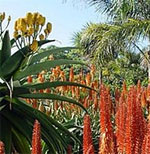 The Story -The Farm`s Title Deed name is ‘GANZEKRAAL’. which means ‘GOOSE CLOSURE/ENCLAVE’. The name was given to the Farm and surrounding area over a century ago when the Wild Geese from the area would fly down during the day and rest in the cattle and sheep closures, foraging on the seeds and pips in the manure, while the animals were out on pasture. this especially happened in times of drought. ‘Ganzekraal’...The Goose Closure! Now , more than 100 hundred years ago, Retief Goosen ‘THE GOOSE’ happened to become acquainted with the present Owner, myself and start up the new company, GOOSE WINES, and produce the World`s only ‘THE GOOSE’ Wine. Coincidence??? No.....something very special and.....almost meant to be. There are 5 large dams on the Farm taht host various wild Water Fowl. In March 2007, only a week after ‘THE GOOSE WINES COMPANY’ was formed, a flock of wild Black ‘spur winged’ Geese moved onto one of these dams and has now made the dam there home. In Afrikaans it is called ‘Wilde Makou’. Africa’s heaviest and largest fresh water flying Goose. This was meant to be. May the Goose spread his wings and it’s Wines fly to all corner of our World, and convey this unique experience to wine lovers and people who are passionate about life. Enjoy!!
The Story -The Farm`s Title Deed name is ‘GANZEKRAAL’. which means ‘GOOSE CLOSURE/ENCLAVE’. The name was given to the Farm and surrounding area over a century ago when the Wild Geese from the area would fly down during the day and rest in the cattle and sheep closures, foraging on the seeds and pips in the manure, while the animals were out on pasture. this especially happened in times of drought. ‘Ganzekraal’...The Goose Closure! Now , more than 100 hundred years ago, Retief Goosen ‘THE GOOSE’ happened to become acquainted with the present Owner, myself and start up the new company, GOOSE WINES, and produce the World`s only ‘THE GOOSE’ Wine. Coincidence??? No.....something very special and.....almost meant to be. There are 5 large dams on the Farm taht host various wild Water Fowl. In March 2007, only a week after ‘THE GOOSE WINES COMPANY’ was formed, a flock of wild Black ‘spur winged’ Geese moved onto one of these dams and has now made the dam there home. In Afrikaans it is called ‘Wilde Makou’. Africa’s heaviest and largest fresh water flying Goose. This was meant to be. May the Goose spread his wings and it’s Wines fly to all corner of our World, and convey this unique experience to wine lovers and people who are passionate about life. Enjoy!!
To Summarise - We have really pioneered a very extreme and unique region. Traditionally apple growing region, we took the challenge, and now we see the unbelievable success in our Wwne styles. We are not copying ‘Cold New Zealand’ or ‘Cool Bordeaux’. We are proudly making a South African wine that will compete with the best the world has to offer. These vines are still young. All the world`s top wines are made from vines 50 years and older! We have utilised the terroir that we have to work with, and achieved truly exceptional wines. The 2005 harvest has now been bottled. The 2006 awaits bottling in 2007, and The 2007 vintage is now fresh on wood for the next 2 years. It will take a few years to get "Momentum" with our stocks. We are small and Boutique if you see the volumes we have to work with. There are no vineyards for 30 kilometres around us, so this appellation is very isolated and unique. There will not be any other wines with these styles made in SA. Top Wine Critics have categorised our wines as ‘Elegant’ and ‘Classic’. Complex fruits yet not overpoweringly ‘Typical New World’. Sort hidden tannins. Balanced alcohol and very exciting acids. The fine balance will be to see which wooden barrels and what ageing periods will bring the best out of the wines.
The Wine - Cabernet Sauvignon - Shiraz
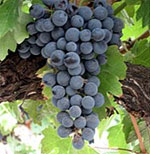 Cabernet Sauvignon (‘CS’) - In 1999 we planted 6 hectares of ‘CS’. Clone 163 was grafted onto rootstock Clone Richter 99 and 110. Rows are 2,7M X 1,0M plantings. Very dense plantings to create smaller Vines with more concentrated growth and reduce vigour. Row direction is north / south to allow good air movement through the rows with the winds that blow from the south. The slope is east facing and very cool. Budding only starts in October, while the Stellenbosch starts budding in late August already. The Vines are trellised very high on a ‘7 Wire Perold System’.
Cabernet Sauvignon (‘CS’) - In 1999 we planted 6 hectares of ‘CS’. Clone 163 was grafted onto rootstock Clone Richter 99 and 110. Rows are 2,7M X 1,0M plantings. Very dense plantings to create smaller Vines with more concentrated growth and reduce vigour. Row direction is north / south to allow good air movement through the rows with the winds that blow from the south. The slope is east facing and very cool. Budding only starts in October, while the Stellenbosch starts budding in late August already. The Vines are trellised very high on a ‘7 Wire Perold System’.
Shoots are allowed to grow as high as 1,5 metres to create maximum leaves to allow optimum leave surface which ripens the grapes well in these cool conditions. Harvesting only takes place as late as 25th April at temperatures of below 20 degrees daily. Good vineyard management and a unique high trellis system allows us to optimumly ripen the grapes phynolicly to about 25-26 degrees balling sugar. These are very ripe and fruity/berry grapes for a cool area as ours. The crops are limited to only 2,5kg per Vine stock.
With about 3300 Vines per hectare, we harvest around 7 tons per hectare. Very small Berries and concentrated Bunches. Dark plum / black colours of grapes with thick strong skins ensure very complex fruit and extremely concentrated flavours and rich colour. Grapes are hand picked early mornings till 10 am, at temperatures below 15 degrees Celsius. Grapes are taken to a cool room at 4 degrees for the day to chill even further before been transported to the wine cellar at night. Crushing of the grapes takes place with the grapes at about 6-9 degrees temperature. Every possibly details is spent to ensure that grapes stay cold, healthy and protected from vineyard to cellar. It is here where the important flavours in the grapes can be lost with wrong practices.
2002 was the first Cabernet Sauvignon harvest of only 1 ton per Hectare and in 2007 about 5 tons per hectare. because of our good sugars, the local birds have taken liking in the grapes, so we now close all our grapes with protective bird netting about 6 weeks before harvest. This costly exercise has ensured us to deliver healthy undamaged grapes for World Class wine making. All grapes are picked , stored and trans- ported in small 20kg lug boxes.
For the 2008 harvest we hope for 7 tons per hectare X 6 ha = about 40 tons. This will give us about 26 000 litres of wine @ 65% extraction. Our wines are crushed with soft destemmers and allowed to ferment in traditional open cement ‘Kuipe’ for about 12 to 15 days. After drawing the juice off the lease the wine is gravitated into French oak barrels where malolactic fermentation continues for up to 8 weeks, after which the wine is racked every 3-4 months. We age our wines according to taste and wood character from 12 to 24 months. 20% new barrels and 80% second and third fills are used.
Shiraz - In 2000 we planted 7 hectares of SH1 Clone Shiraz on 101-14 rootstock Clone. because of Shiraz’s vigorous nature we allowed for further spacing of 1,25M spacing in 2,7M rows. (ie, less plants per ha). A warmer and very stony western slope was chosen for the planting. Rows were ridged to ensure good drainage. Shiraz must have healthy roots and well drained soils to ensure full bodied grape flavours and colours.
Row direction is east / west which allows for very good sunlight penetration and optimum ripening. The trellis system is also very high as discussed before, and shoots are long with many leaves to ripen the grapes in these cold conditions. Because of the row direction at 90 degrees to our southerly Ocean strong winds, we have built high wind protection barriers to protect our Vines from the wind damage, but yet allowing necessary wind flow to cool down the vines in summer.
The Wine - Shiraz – Sauvignon Blanc
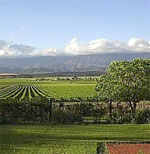 The Shiraz ripens well every year on these west facing slopes and the stony soils have proven to give the grapes a unique terroir taste. Small berries and dark red rich royal colour ensures heavy coloured wines. Our Shiraz is harvested in late March about a month before the Cabernet. This helps us to complete the picking process and the wine making process and have the cellar clean and ready for the next Cabernet cultivar.
The Shiraz ripens well every year on these west facing slopes and the stony soils have proven to give the grapes a unique terroir taste. Small berries and dark red rich royal colour ensures heavy coloured wines. Our Shiraz is harvested in late March about a month before the Cabernet. This helps us to complete the picking process and the wine making process and have the cellar clean and ready for the next Cabernet cultivar.
We have been harvesting Shiraz since 2003 and in 2007 we produced about 5 tons per hectare. In 2008 we would also hope for 7 tons/ hectare X 7 hectares = about 50 tons. At 65% extraction we will have about 33 000 litres of wine. Our Shiraz is a very exciting wine which has won numerous awards at the young Wine Shows in SA. The wines are extremely herbaceous and peppery, with strong pleasant white pepper nose. The 2005 vintage our Shiraz and Shiraz/ Cabernet blend were both voted best wines in SA in their respective Classes at the National Young Wine Show.
The same processes of picking, storage and transporting takes place with our Shiraz as explained above with the Cabernet Sauvignon, as well as the basic winemaking process. Our Shiraz colour have been explained by most visiting Winemakers as the darkest coloured Shiraz grapes they have seen. Our sugars at harvest are also about 25-26 degrees balling.
Sauvignon Blanc - 4 hectares planted in 2002 and 2 hectares planted in 2005. The first planting was done on a cold south/ east facing slope of dark crush soils overlaying a Clay B Horison layer of subsoils. These clay subsoils are very cold and this is what we want to achieve with our vineyards. Clone 11 (weatherstation clone) was crafted onto 101-14 Rootstock Clone. Plantings were done at 2,7M X 1,25M. Row direction is north/ south to allow the face of the wind to be channelled up through the vineyard row direction for maximum cooling and movement without damage.
These Sauvignon Blanc vines are planted on the coldest part of the Farm in the face of the rushing wind as it races down the high mountain slopes. Our challenges are "Stunted Growth" but this has been overcome with timely irrigation scheduling and tree plantations as wind barriers. A very high 7 wire trellis system is used to allow shoots to grow high and generate as much sugar and optimum ripening under these cold and windy conditions. At harvest in early middle March the sugars are at about 22–23 degrees balling with acids as high as 11.5! These vines are also protected with bird netting to ensure no grape damage.
White cultivars are more prone to rotting so this practice is very important. We believe that our Sauvignon Blanc is growing in South Africa’s coldest and most abrasive weather conditions. These vines need to mature over the next few Years for the wine to prove itself. We only harvested our first 15 tons this year in 2007. In 2008 we expect about 25 tons which will give us about 18 000 litres of wine at 70% extraction. Some of the Wine (15%) is aged in oak barrels for about 3 months. This is then blended with the other to create a more rounded finish and smooth feel. Our acids are very high, and we will be ripening our grapes to about 24 balling for the acids to drop at harvesting in the future.
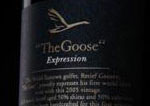 Product Description: The Goose Expression
Product Description: The Goose Expression
Vintage : 2005
Grower : The Goose Winery
Vineyard Name : Ganzekraal
Regions: Southern Capo – Langkloof Valley
Area of Origin: Wine of Origin Upper Langkloof Valley
Region / Viticulture: The Upper Langkloof (long valley) runs east/west to the north of the Outeniqua mountains, only 15 km from the Indian Ocean coastline situated 2500 ft above sea level. The Valley is known for a dry and cold climate. The annual average rainfall is about 250mm to 300mm. Strong and cool summer winds rush in on shore off the coast every day, and rise over the 5000 ft mountain range cooling even more. These winds bring in cold and moist air which cools down the Valley during summer to temperatures of 20 to 23 degrees, while the nearby Karoo bakes away at 40 degrees in summer. Extreme Terroir and an exciting region, motivated me to install aweather station and research the area for the possible planting of vineyards in 1993. Soil samples and profile holes were sunk to determine the soil types and structures, to accurately determine the proper vine selection of cultivar for planting.
It was found that the Valley has an annual temperature of only 17 degrees Celsius (very cool for S.A!) The soils are from Table Mountain sandstone and shale combination. Deep stony red soils – good for drainage. Very small Berries and concentrated Bunches. Dark plum / black colours of grapes with thick strong skins ensure very complex fruit and extremely concentrated flavours and rich colour. Grapes are hand picked early mornings till 10 am at temperatures below 15 degrees Celsius.
Vinification Details Cabernet Sauvignon: Grapes are taken to a cool room at 4 degrees for the day to chill even further before been transported to the wine cellar at night. Crushing of the grapes takes place with the grapes at about 6-9 degrees temperature. Every possibly details is spent to ensure that grapes stay cold, healthy and protected from vineyard to cellar. It is here where the important flavours in the grapes can be lost with wrong practices. All grapes are picked, stored and transported in small 20kg. Our wines are crushed with soft destemmers and allowed to ferment in traditional open cement ‘Kuipe’ for about 12 to 15 days. After drawing the juice off the lease the wine is gravitated into French oak barrels where malolactic fermentation continues for up to 8 weeks, after which the wine is racked every 3-4 months. We age our wines according to taste and wood character from 12 to 24 months. 20% new barrels and 80% second and third fills are used.
Vinification Details Shiraz: Shiraz grapes follow the same procedure as the Cabernet grapes. Very strict rules Are followed with the correct temperature of picking the grapes. Our grapes only ripen in Autumn and daily temperatures are down to 15 – 18 degrees already. Each grape picker would complete his/her lugbox and carry it out of the vineyard rows and put it into the waiting trailer in the pathway. The trailer would drive to the coolroom and load the lugboxes in there to stay cool for a couple of hours, till the transport takes the grapes to the cellared. As far as our knowledge goes, no other producer is still cooling the grapes further down in a cool room before transportation. The Shiraz is also made in a similar manor as above.
Varietal Composition: 50% Cabernet Sauvignon, 50% Shiraz
Tasting Note: The Goose Expression 2005 is no typical new world ‘shouting out loud’ wine. No, we have created a classical, elegantly structured wine with fine lines of character with hidden fruits that come to the fore wit enjoying a meal. Second fill barrels make that there is not a strong wood tannin flavour, and we’ve achieved a subtle balance between fruit, wood, acid and alcohol. Fine wine critics have also labelled our wine style as extremely well balanced wine
Food Match: Our wines are matched well with venison and meat dishes. The spicier component of Shiraz in the wine Compliments any curry dish too. Rack of Lamb is a favourite with the berry characters fused with the Cabernet Sauvignon
Ageing Potential: Best drunk within 15 years
Alcohol : 14.18%
AT : 4.40 g / l H2S04
pH: 3.30
SO2 total : 145 mg / l
All prices excl. VAT



